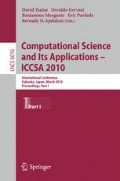Abstract
In this paper, two-dimensional manifolds in three- dimensional Euclidian space are considered in order to single out surfaces whose skeletons fulfill the grass-fire concept. Among such surfaces we distinguish those ones that can be covered by finite number of adjacent patches. We name them multi-ribbon surfaces. We aim to calculate a multi-ribbon surface skeleton by constructing every patch Voronoi diagram in a surface parameter space and merging all Voronoi diagrams. Voronoi diagrams merging technique is proposed. The introduced approach can be applied to the problems of geographic information systems (for example, to street network modeling).
Access this chapter
Tax calculation will be finalised at checkout
Purchases are for personal use only
Preview
Unable to display preview. Download preview PDF.
References
Bhattachary, P., Rosenfeld, A.: Polygonal Ribbons in Two and Three Dimensions. Pattern Recognition 5, 769–779 (1995)
Blum, H.: A transformation of extraction new descriptors of shape. In: Proc. Symposium Models for the perception of speech and visual form, pp. 362–381 (1967)
Chazal, F., Soufflet, R.: Stability and finiteness properties of Medial Axis and Skeleton. Journal of Dymamical and Control systems 10(2), 149–170 (2004)
Choi, H.I., Choi, S.W., Moon, H.P.: Mathematical Theory Of Medial Axis Transform. Pacific Journal of Mathematics 181(1), 57–88 (1997)
Chavel, I.: Riemannian Geometry: A Modern Introduction. Cambridge University Press, Cambridge (1993)
Cornea, N., Silver, D., Min, P.: Curve-skeleton properties, applications and algorithms. IEEE Transactions on Visualization and Computer Graphics 13(3), 530–548 (2007)
Dutta, D., Hoffman, C.M.: A Geometric investigation of the skeleton of CSG objects. In: Ravani, B. (ed.) Proc. 16th ASME Design Automation Conf.: Advances in Design Automation, Computer Aided and Computational Design, Chicago, Ill, vol. 1, pp. 67–75 (1990)
Gursoy, H.N.: Shape Interrogation by Medial Axis Transform for Automated Analysis. PhD thesis, Massachusetts Institite of Technology (1989)
Karavelas, M.I.: Voronoi diagrams in Cgal. In: 22nd European Workshop on Computational Geometry, pp. 229–232 (2006)
Karavelas, M.I., Yvinec, M.: The Voronoi diagram of Planar Convex Objects. In: Di Battista, G., Zwick, U. (eds.) ESA 2003. LNCS, vol. 2832, pp. 337–348. Springer, Heidelberg (2003)
Lee, D.T.: Medial Axis Transformation of a Planar Shape. IEEE Transactions on pattern Analysis and Machine Intelligence PAMI-4(4), 363–369 (1982)
Mekhedov, I., Kozlov, A.: Street network model based on skeletal graph. In: Proc. of 19 Int. Conf. Graphicon, pp. 356–359 (2009) (in Russian)
Mestetskiy, L.: Continuous morphology of binary images: figures, skeletons and circles. Moscow, FIZMATLIT (2009) (in russian)
Mestetskiy, L.: Skeletonization of a multiply connected polygonal domain based on its boundary adjacent tree. Sibirian Journal of Numerical Mathemathics 9(3), 299–314 (2006) (in Russian)
Mestetskiy, L., Semyonov, A.: Binary Image Skeleton - Continuous Approach. VISAPP (1), 251–258 (2008)
Na, H.-S., Lee, C.-N., Cheong, O.: Voronoi diagrams of the sphere. Computational Geometry 23, 183–194 (2002)
Preparata, F.P.: The Medial Axis of a Simple Polygone. In: Goos, G., Hartmanis, J. (eds.) Lecture Notes in Computer Science: Mathematical Foundations of Computer Science, pp. 443–450 (1977)
Siersma, D.: Voronoi diagrams and Morse Theory of the Distance Function. In: Barndorff-Nielsen, O.E., Jensen, E.B.V. (eds.) Geometry in Present Day Science, pp. 187–208. World Scientific, Singapore (1999)
Wolter, F.-E.: Cut Locus and Medial Axis in Global Shape Interrogation and Representation. In: Design Laboratory Memorandum 92-2. Department of Ocean Engineering, pp. 92–92. MIT Press, Cambridge (1993)
Wolter, F.-E.: Distance function and cut loci on a complete Riemannian manifold. Archiv der Mathematik 32, 92–96 (1978)
Author information
Authors and Affiliations
Editor information
Editors and Affiliations
Rights and permissions
Copyright information
© 2010 Springer-Verlag Berlin Heidelberg
About this paper
Cite this paper
Mekhedov, I., Mestetskiy, L. (2010). Skeleton of a Multi-ribbon Surface. In: Taniar, D., Gervasi, O., Murgante, B., Pardede, E., Apduhan, B.O. (eds) Computational Science and Its Applications – ICCSA 2010. ICCSA 2010. Lecture Notes in Computer Science, vol 6016. Springer, Berlin, Heidelberg. https://doi.org/10.1007/978-3-642-12156-2_42
Download citation
DOI: https://doi.org/10.1007/978-3-642-12156-2_42
Publisher Name: Springer, Berlin, Heidelberg
Print ISBN: 978-3-642-12155-5
Online ISBN: 978-3-642-12156-2
eBook Packages: Computer ScienceComputer Science (R0)

